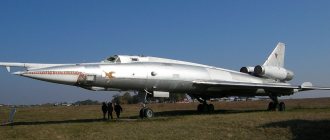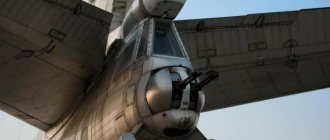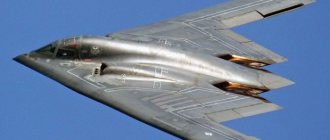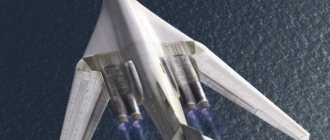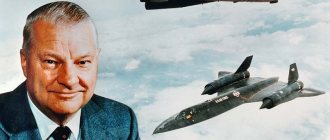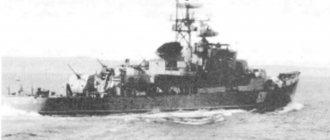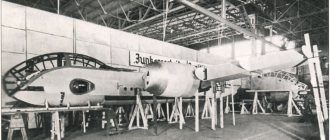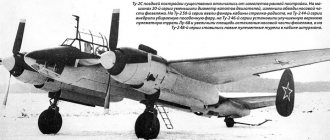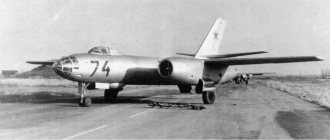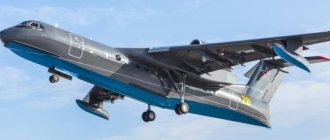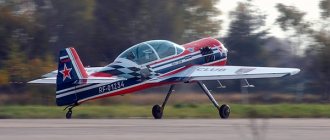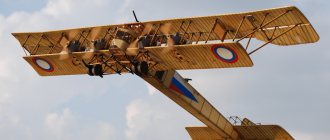“Cart-Start” is used when aircraft urgently need to take off. For example, this could be a combat alert. Due to such a launch, it takes only 10 minutes to prepare for departure, and not a whole hour, as with a normal launch. With such efficiency, the B-52 Stratofortress fires two engines and begins taxiing for takeoff. Along the way, the remaining power plants are launched.
This method - ground personnel at American airfields call it Cart-Start - is used when the plane needs to be lifted into the air as quickly as possible.
The Boeing B-52 bomber replaced the aging B-36 in 1955. Stratofortress can carry various types of weapons on board (nuclear weapons are no exception) at subsonic speeds and altitudes of up to 15 kilometers.
It is known that initially the development of the B-52 was carried out for the theoretical delivery of two thermonuclear bombs of colossal power to any point in the USSR.
In addition, this Boeing model is the absolute record holder for flight range among combat aircraft of its class, and the fact that this modification has been in service for more than 50 years is a rarity for such equipment.
B-52
This process eliminates the need to use ground equipment. It is noteworthy that the six engines that are not running at the time of launch are started before the actual takeoff - when the B-52 reaches the end of the runway.
B-52 bomber
The aircraft is made according to a normal aerodynamic design with high wings. The aircraft is equipped with eight engines located in twin engine nacelles.
The aircraft's navigation and bombing systems are analog. The first modifications of the aircraft had an APS-23 radar, a range finder, and a bomber optical sight; later they decided to abandon the optical sight. Later versions of the B-52 were equipped with the AN/ASQ-151 optical-electronic vision system, which allowed the aircraft to avoid obstacles at low altitudes, a camera for low light levels, and an IR vision system for the forward hemisphere.
The Boeing B-52 Stratofortress has one of the most powerful electronic warfare systems among US combat aircraft. It includes equipment for producing misleading and noise interference, heat traps and dipole reflectors. In addition, B-52 bombers of modifications G and H are equipped with AN/ALQ-122 electronic radar systems designed to suppress enemy radar, jamming transmitters, aircraft radar warning equipment, an AN/ALQ-153 pulse-Doppler tail protection station, and jamming transmitters AN/ALT-28. The total weight of electronic warfare equipment is 2.7 tons.
The US Air Force B-52 strategic bomber conducted a training bombing of Crimea
ALL PHOTOS
A pair of US Air Force B-52H Stratofortress strategic bombers conducted a training flight over the Black Sea as part of "integration and preparation for interaction with European allies and partners"
"A B-52 aircraft from the 2nd Bomb Wing, operating out of U.S. Air Force Fairford, UK, recently returned from a mission in the Black Sea region that focused on training to integrate and interact with European allies and partners," the report said.
The B-52H Stratofortress aircraft were deployed to Britain from Barksdale Air Force Base in the US state of Louisiana, home to the 2nd Bomb Wing of the US Air Force.
A pair of US Air Force B-52H Stratofortress strategic bombers conducted a training flight over the Black Sea as part of "integration and preparation for interaction with European allies and partners." This was reported in a press release from the command of the US Armed Forces in Europe.
The flight of bombers capable of carrying nuclear weapons lasted 12 hours and, as reported on the website of the press service of the US Air Force Command in Europe, during it a joint training was conducted with the military of Romania, Ukraine and Georgia.
"A B-52 aircraft from the 2nd Bomb Wing, operating out of U.S. Air Force Fairford, UK, recently returned from a mission in the Black Sea region that focused on training to integrate and interact with European allies and partners," the report said. .
According to the monitoring resource PlaneRadar, the flight took place on October 19, while one of the B-52Hs approached Crimea and simulated a bombing of the island.
17:50 Moscow time. “Bombed”… pic.twitter.com/8VETZQPjt2— PlaneRadar (@ua4wiy_) October 19, 2020
The Russian Ministry of Defense told TASS that the flight of a US Air Force B-52H bomber over the Black Sea on October 19 was controlled by a Russian Aerospace Forces Su-27 fighter. “Approaching the state border of the Russian Federation, the bomber was met by a Russian Su-27 fighter from the air defense forces on duty in the Southern Military District and was accompanied by it throughout the entire section of its flight along the border of Russian territorial waters at a distance of about 70 km from it,” the department specified. .
Members of the 2nd Bomb Wing, based at Barksdale Air Force Base, Louisiana, train with European allies. These maneuvers are aimed at increasing global stability and security.
On October 10, the United States deployed an aviation group consisting of four B-52H strategic bombers to forward base Fairford in Great Britain. Moreover, after the transatlantic flight, three B-52H bombers initially made demonstrative approaches to the borders of the Kaliningrad region, and then landed in England.
During their stay in Britain, American bombers have already completed a series of training flights, in particular, they have practiced striking training targets at a number of European training grounds of NATO member countries.
The B-52H Stratofortress aircraft were deployed to Britain from Barksdale Air Force Base in the US state of Louisiana, home to the 2nd Bomb Wing of the US Air Force. At the same time, a press release from the US Air Forces in Europe, announcing the redeployment of the B-52H to England, was issued under the heading: “For the attention of adversaries, the bombers are back and ready for action.”
In March of this year, the US Air Force also deployed six B-52H strategic bombers to the UK for a short time. In particular, they carried out a series of training flights in close proximity to the Russian borders in the Baltic region, practicing air strikes, Interfax reports.
After simulating the bombing of a Baltic Fleet base and bombers flying over the Kaliningrad region, the Russian military scrambled fighters several times. The Kremlin then said that the appearance of American bombers near Russian borders creates additional tension.
US European Command consists of approximately 70,000 military and civilian personnel. Its scope covers all of Europe, parts of Asia and the Middle East, the Arctic and Atlantic oceans. The US command is responsible for US defense operations and relations with NATO and 51 countries.
The Boeing B-52H Stratofortress was produced between 1952 and 1962 and was designed as a strategic bomber capable of delivering two high-yield thermonuclear bombs to any point in the USSR. Today it remains the main long-range bomber aircraft of the US Air Force.
Will an old horse ruin the furrow?
Why is the Air Force seeking to preserve a strategic bomber designed to destroy the cities and military installations of an enemy that no longer exists, namely the USSR? During the Cold War and after its end, the Americans managed to radically reformulate the mission of the B-52 .
Patrols, in the interests of the strategic command of the US Air Force with thermonuclear weapons on board, ready to destroy any areas of the Soviet Union, were replaced in the 60-70s of the twentieth century with carpet bombing of the territories of Vietnam, Cambodia and Laos. The aircraft eventually became a multi-role platform supporting many types of air operations, from its original role of strategic bombing to maritime patrol and operation as a missile launcher beyond the range of enemy air defenses. These roles cannot be easily replaced by the future B-21 Raider , and so the Air Force is committed to keeping the B-52 in service for as long as possible.
A service life of close to 150 years seems crazy and unsuitable for an aircraft, but there are precedents for some types of military equipment being preserved for incredibly long periods of time. As a rule, these are ships, in particular the USS Blue Ridge , an amphibious command ship launched in 1969 and still in service. The Russian Navy even has a submarine rescue ship, the Kommuna , which began service in the Tsarist Navy in 1915 and continues to serve in the Russian Navy.
ships will pale in comparison to the nearly 150-year service life of the B-52 General Electric proposed as part of its plan . Aircraft are resilient enough to return to service even after a major fire or damage. However, there is no way to know for sure how they will cope with changes in their operational use, changes in the environment, or even simply metal fatigue from aging.
One thing is for sure. Over the decades, generations of military specialists and engineers have turned the bomber into a formidable component of American strategic and tactical forces. If you double the aircraft's career, you'll see at least six generations of pilots flying the B-52 , adding to the myths and legends surrounding the eight-engine monster .
Can you believe this? As for the crews, their level of training was very high. The Emes flew two shifts a week, and the commander averaged 120 hours of flight time per year. Tactical launches were carried out beyond Norway, in the area of the Aleutian Islands, near Alaska and Canada. The air defense of the North American continent reacted to these raids very clearly: after all, they did not know what was on the minds of “these Russians” and therefore were afraid. As a rule, the trio of F-15s, accompanied by the KS-135 tanker, met the Soviet missile carriers 200-300 kilometers after the North Pole. Then, alternately refueling, the Americans “drove” the Tu-95MS along their entire more than 2,000-km route and drove off, having not flown 300 kilometers to the territorial waters of the USSR, and the “EMS” landed in Anadyr or Magadan.
The crews of the Tu-95MS rated its defensive capabilities very highly, considering the aircraft literally “unbreakable.” The airborne defense system (ADS) of this aircraft was the most advanced in the Union and was superior to the B-52N complex in a number of indicators. Unlike the Tu-160, the EMS successfully solved the problems of electromagnetic compatibility, and in 1987, during special tests, its electronics brilliantly thwarted all attempts to attack the most modern MiG-31 interceptor. The flight took place at night in the PMU at an altitude of 8000 m. The MiG pilot reported: “I am observing the target visually, I can work with the gun, it is impossible to carry out a tactical launch.” As you can see, on the “emes” the stern gunner again acquired its former meaning.
Combat duty was again organized on the Tu-95MS. However, the crews who boarded it no longer experienced the same psychological stress as their predecessors on the bombers. Firstly, they should not have entered a zone with powerful air defense, and secondly, they did not know their targets, or even the launch point. Their task is to bring the plane to a certain place, from where it, controlled by automation, must fly for another hour, and then independently launch missiles. Thus, the pilots took no sin on their souls. But even this scenario, free from the unreliable human factor, turned out to have a weak point. According to the creators of the “emes”, before turning on the offline mode, it is necessary to correct the course according to the stars. At the same time, for some reason they did not take into account that a real combat mission should take place at low altitudes, and the stars could be obscured by clouds. After several disrupted tactical launches, changes had to be made to the on-board computer programs... Tu-95 (Part No. 2)
How to drink
A properly prepared cocktail is half the battle. Now we need to learn how to drink it correctly, because there is a “recipe” for this:
- The first option on how to drink B-52 involves using a straw. It is inserted before lighting the drink and drunk immediately so as not to melt the straw. The interesting thing is that the lower layers do not yet have time to warm up and the person starts drinking the cocktail cold and ends up hot. According to B-52 fans, this is the effect they like most.
- If you don’t want to use a straw, you can simply drink the cocktail in one gulp. The main thing is not to “sip” it down.
Bartenders who have seen different types of drinking this drink in their lifetime claim that the first option is more dangerous in terms of “early” intoxication.
The most common cocktail compositions b 53
There are three main recipes that we will talk about.
B-53 (B-53) cocktail recipe No. 1
- Mexican coffee liqueur Kahlúa – 15ml.
- Sambuca (Sambuca) – 15ml.
- Orange liqueur (Cointreau, Grand Marnier) 15 ml.
B-53 cocktail recipe No. 2
- Mexican coffee liqueur Kahlúa – 15ml.
- Baileys liqueur – 15ml.
- Vodka – 30ml.
B-53 cocktail recipe No. 3
- Mexican coffee liqueur Kahlúa – 15ml.
- Baileys liqueur – 15ml.
- Absinthe – 30ml.
Combat aircraft: Junkers Ju.52/Зm - strange, but very useful
If you look at the memoirs of World War II, the bulk of the memories will be about a completely outdated low-speed three-engine aircraft. In fact, the devil is in the details, and under the Junkers Ju.52 markings there is a little more than an old aircraft with fixed landing gear.
Let's go in order.
I will not sin at all against the truth when I say that “Aunt Yu” became one of the first multi-purpose aircraft in the world.
Yes, details are a strong and difficult thing. And it’s all about the numbers after the abbreviation familiar to everyone.
Corrugated skin, non-retractable landing gear, slow and unassuming - this was the aircraft that we usually think of as the Ju.52. More precisely, about Ju.52/Зm . Three-engine version (there was also a single-engine version).
A strange and somewhat archaic design, however, this aircraft has accomplished so much that it is difficult for many real combat aircraft to compete with it.
Our story began in 1933, when the Ju.52/3m-ge modification appeared, which became the first truly large-scale version. Engines from Pratt and Whitney were replaced with BMW-132A-1. In general, in fact, a licensed Hornet from the same Pratt and Whitney with a capacity of 660 hp.
Ju.52/3m-ge had a maximum speed of 290 km/h. This, of course, was minuscule, but for a civilian model the maximum speed was not so important, but the fact that the aircraft could easily be converted into a transport or bomber was very valuable.
This played a role because, before commercial sales had even begun, it received an order to convert the aircraft into a bomber.
October 1933. The newly formed air commissariat creates the so-called auxiliary bomber squadron. In general, this can be called both the formation of the Luftwaffe bomber aviation and the Luftwaffe itself.
In general, according to the original plan, it was planned to arm all bomber aircraft with the Dornier Do.11 aircraft, and the Junkers Ju.52 was considered only as a temporary solution.
Dornier Do.11
But it turned out that Dornier was unable to teach its plane to fly; it went into production with delays and problems, so much so that by the reporting date of March 1, 1933, the bomber squadron had three Do.11c, but the Junkers Ju.52 was 24.
It so happened that Junkers was ready to rivet the 52nd at a completely Stakhanov pace, which is what actually happened.
And everything turned out to be very simple. Converting the transport Ju.52/3m-g3e into a bomber was a very simple matter. A hatch was simply cut into the top of the fuselage, and an open turret with one MG-15 machine gun was installed in it.
To protect against attacks from below, there was a “basket” partially retractable in flight with another MG-15. This shooting point could be pulled halfway into the fuselage completely manually.
The “basket” point was attached to the glazed bombardier’s cabin, which was located between the bomb bays. There were three bomb bays: two in front and one in the back. Each bomb bay could accommodate a DSAC/250 cassette for 10 50 kg bombs or two 250 kg bombs.
Thus, the bomb load was 1500 kg. A fuel supply of 2475 liters provided a tactical range of 500 km at a cruising speed of 245 km/h at an altitude of 1000 m.
It is clear that all these alterations were very easily rolled back into the transport version.
The transport version of the Ju.52/3m-g3e was the first to take part in combat operations. Of course it was Spain. 20 Junkers flew 461 sorties in July-August 1936, transporting 7,350 infantry, artillery and machine guns from Africa to Spain. The planes made 461 flights, often overloaded. Another 5,455 people were carried on 324 flights in September. And in October they transported another 1,157 people on 83 flights.
Hitler quite rightly noted: “Franco should erect a monument to Ju.52. The victory of the revolution in Spain is due to this aircraft.”
While the transport Junkers were transporting reinforcements to Franco's army from Africa, their bomber colleagues were baptized. The first use occurred on August 14: Ju.52/3m-g3e bombed the Getafe airfield near Madrid.
And on August 27 and 28, Madrid became the target of the Ju.52/3m, and the situation turned out to be very difficult. It turned out that both Ju.52/3m with bombs and Ju.52/3m with passengers were flying to Madrid at the same time, since Lufthansa continued to operate passenger flights to Spain.
In general, the combat use of Ju.52/3m-g3e and g4e showed that the aircraft turned out to be successful. And real large-scale construction and, at the same time, modification of the aircraft began.
Ju.52/3m-g5e has become even more versatile. The plane received a rear wheel instead of a “crutch”, a ski landing gear for the winter period and floats. The defensive armament changed; instead of the “basket”, which greatly worsened the aerodynamics, two MG-15 machine guns were installed on the sides, and the “basket” was removed. Ju.52/3m-g5e received BMW-132T-2 engines with a power of 830 hp, the exhaust gases of which were used in the anti-icing system.
"Junkers" with floats from
Winter option
And, of course, the Luftwaffe leadership was waiting for the moment when all these innovations could be effectively applied. And it waited. In Operation Weserubung, the Junkers performed remarkably well, transporting six companies of paratroopers, one landing battalion and three infantry battalions to Norway. Additionally, the aircraft carried six companies of airfield service personnel, the headquarters of the aviation forces, the headquarters of the infantry regiment and more than 168 tons of fuel.
Among other things, by the beginning of the active phase of World War II, Ju.52/Zm had mastered the profession of a minesweeper. Based on the Ju.52 (models g4e, g5e, g6e, g7e and g8e), six squadrons of “mine hunters” were formed, denoted by the letters MS in the specifications.
Most Ju.52/3m (MS) were equipped with a large duralumin ring on the struts under the wing and fuselage. The winding in the ring was powered by an auxiliary motor providing a current of 300 amperes. Other Ju.52/3m (MS) were equipped with KK-Gerat containers with 30 small charges for sweeping acoustic mines. Most minesweeper squadrons had an equal mix of both.
It was used like this: three Ju.52/3m with magnetic windings flew in a “wedge” formation. Ju.52/3m with demolition charges flew behind them. The flight speed was usually 200 km/h. The height depended on the depth of the sea. The optimal distance to the mine was 40 m, so if the depth was 30 m, then the planes flew at an altitude of 10 m. The application showed the high efficiency of such minesweeping, but losses immediately began, as the enemy began to “educate” the Junkers pilots.
Since the Luftwaffe and Kriegsmarine valued the work of minesweepers, measures were taken to strengthen defensive weapons. Instead of the top machine gun, a circular rotation turret with an MG-151/20 cannon was installed, and the side MG-15s were replaced with large-caliber MG-131s. The minesweeper has become a very “toothy” aircraft.
But the gun was not included in the standard configuration. We decided that it would be a bit greasy. And in the Ju.52/3m-g8e modification, the MG-131 was installed instead of the upper MG-15 machine gun.
In general, to re-equip the Ju.52/Zm for various tasks, seven standard “field conversion kits” were used, which could be installed in operational units.
That is, the aircraft could be modified to perform specific tasks, and the use of such a set was indicated by an additional letter:
- E - the aircraft was equipped to load, secure and unload/eject containers.
- F - landing aircraft.
- H - training aircraft.
- N - cargo plane.
- R - communication aircraft.
- S - ambulance plane.
- St - aircraft for transporting technical personnel.
In 1942, the Ju.52/3m-g9e, a glider towing vehicle, went into production. We took into account the experience of European landing operations, significantly strengthening the landing gear and installing the towing system itself as standard. Another subspecies in the already decent list of “professions”.
The finest hour of “Aunt Yu” came in January 1942, when the Red Army surrounded the 100,000-strong Wehrmacht group near the city of Demyansk. In order to organize supplies for the encircled troops, the German command took away planes even from Rommel in Africa, which unwittingly accelerated the collapse of the Africa Corps.
But, nevertheless, the Germans managed to create an air bridge and during the period from February 21 to May 18, eleven air transport groups made 14,445 sorties, transported 24,303 tons of cargo, 3,142 tons of fuel and lubricants, 15,445 people and evacuated 22,093 wounded.
This is not to say that everything was smooth and smooth. Yes, our army did not have experience in such operations at that time, so the Demyansk cauldron can rightly be credited to the Wehrmacht and Luftwaffe.
However, the 265 aircraft lost by the Luftwaffe during the operation is also a lot. It is worth noting that our command made the appropriate conclusions, and when the Germans set out to help the encircled army of Paulus in Stalingrad in the same way, you yourself know how it ended.
Luftwaffe losses at Stalingrad are estimated at about 500 aircraft, of which 266 were Ju.52/3m. It is very difficult to recover from such losses.
Nevertheless, the Ju.52/3m flew until the end of the war as a transport and landing aircraft, especially since its production was increasing, thanks to the fact that French enterprises began to assemble it in decent quantities. The German command involved the Amio concern in the case, and the process began.
Thanks to the work of the French, the assembly of Ju.52/Zm in 1943 increased to 900 aircraft, with 321 aircraft made in France and about 30 more assembled by the Hungarian allies.
The last production version of “Aunt Yu”, Ju.52/3m-g14е, was put into production in the late autumn of 1943 and was produced until mid-1944. This was the last modification of the aircraft, after which production ceased.
In total, since the beginning of 1939, 3225 military aircraft were produced, and the total production of Ju.52/Zm was 4845 units.
Compared to fighters, which were produced in tens of thousands, this is not much. However, the aircraft became the main means of delivering cargo by air for the Third Reich. North Africa, Demyansk, Stalingrad, Crimea, Kamenets-Podolsky, where the 1st Tank Army of the Wehrmacht fell into the bag, Breslau... In general, “Aunt Yu” became a kind of symbol of last hope for the surrounded German soldiers. And the further towards the end of the war, the more often this happened.
The last case of mass successful use of Ju.52/3m was the offensive operation in the Ardennes, “Watch on the Rhine”. The weather was not the most favorable, but nevertheless the Junkers were able to launch an airborne assault in the rear of the American troops.
It is clear that at the end of the war the pilots were no longer the same as at the beginning, and the landing force was dropped over a larger area than planned. However, in the process of reaching their own, the paratroopers were able to “make some noise.”
In general, the Ju.52/3m went through the war from start to finish. And it became the same paradox as Po-2 , since it did not meet any requirements of the time at all. And yet, even in this case, the aircraft brought very tangible benefits.
Characteristics of Ju.52/Zm-g7e:
Wing span, m: 29.30 Length, m: 18.90 Height, m: 5.55 Wing area, m2: 110.00
Weight, kg - empty aircraft: 6,500 - normal take-off: 10,500
Engines: 3 x BMW-132T-2 x 830 l. With. Maximum speed, km/h: 285 Cruising speed, km/h: 250 Practical range, km: 1090 Maximum rate of climb, m/min: 175 Practical ceiling, m: 5,900 Crew, persons: 3 Payload: 18 passengers/troop or 1500 kg of cargo
Armament: - one 7.92 mm MG-15 or 13 mm MG-131 machine gun on the top turret - one MG-15 above the cockpit - two MG-15 or MG-131 in the side windows - 10 bombs of 50 kg bombs or 2 bombs 250 kg.
It is surprising, looking at the flight characteristics, how “Aunt Yu” was able to fly throughout the war, and not as a target, but bringing real benefit. By the way, our plane also worked after the war.
After the end of the war, the aircraft was produced in France (until 1947) and Spain (until 1952), about 1000 aircraft were produced, which operated until the 70s of the last century.
/Roman Skomorokhov, topwar.ru/
Source
303
Cocktail B52: composition and recipe
The B-52 cocktail is prepared in shots of the same diameter throughout the entire height. The ingredients are in a 1:1:1 ratio.
- Kahlua liqueur is poured into the bottom.
- You need to pour (or, as they say, “lay out”) Baileys on top. To do this carefully without mixing the ingredients, you need to pour the liquid along the blade of a knife or along the back of a spoon.
- The last layer is Cointreau orange liqueur. It is poured in the same way as the previous drink.
When preparing a cocktail, you need to make sure that the layers do not mix, since this is the whole point of the drink. But since the B-52 cocktail contains fairly dense liqueurs, this can be achieved after a little training. For greater effect, the B-52 can be set on fire at the end.
